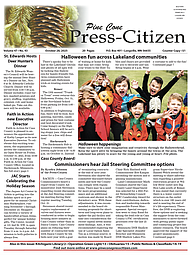June 10, 2021 at 1:12 p.m.
Duck stamps on the wane?
Inside the Outdoors
After asking us about "our luck," and checking the ducks we had harvested, he asked to see the shells we were using, and performed the magnet test. Back then, before the development of some of the sophisticated nontoxic alloys, the only shotshell pellets that would not poison ducks and geese that inadvertently ate them, were made of steel. If your shotshells failed the magnet test, meaning that they contained lead, you could count on a citation.
The warden then asked for our licenses. We had them, of course, along with both the federal and state duck stamps required to hunt ducks and geese. These stamps, which always feature an artist's rendering of a duck or goose, generate revenue to be used in waterfowl conservation work. Some of the artists who have created these stamps have become minor celebrities, and more than a few have had their art careers and ultimate financial success "made" by winning one of the annual contests.
Being a law-abiding hunter, I was not expecting to be criticized for the way I had signed my name across the face of the duck stamps. "You need to sign your name so it's large enough to read," said the warden. "I'm not giving you a citation, but remember that next time." I didn't exactly take offense, but I was just a bit put-out.[[In-content Ad]]
I had signed my name quite small, placing my signature over a dark portion of the artwork on the stamp. I had signed the stamp in this manner on purpose, so that my signature would detract as little as possible from the beauty of the tiny work of art, which many of us carry around in our wallets during hunting season, and afterward keep or display. Like postal stamps, some of the less common, or older, ones have gone up in value; those in the best condition are the most prized.
The warden was right, inasmuch as part of his job was to make sure that the hunter whose license he checked had bought the duck stamps, too, instead of using someone else's. If you can't read a signature, you can't confirm that the hunter you are checking has purchased the stamps to comply with the law.
Sadly, this duck stamp scenario may be going the way of the computer floppy disk, the videocassette movie player, and cassette music tapes. The hunting license and hunting stamp process has evolved into a computerized purchase, one that either happens at a limited number of "plugged in" license outlets, or online, via your computer. The days of going to a U.S. Post Office for the federal duck stamp, then to the hardware store for your hunting license and state duck stamp, are over.
One of the casualties of that transformation is the loss of the stamp's relevance, due to a seemingly harmless word called "validation." Today, when you purchase your hunting license at the nearest Fleet Farm or Gander Mountain, or online yourself, you have a choice as to whether you want your Minnesota duck stamp, or just a line printed on your license that said you paid for it.
To actually get the stamp, you have to pay an additional $2, and you will receive it later in the mail. In a recently published daily newspaper story, it was reported that only about 11 percent of Minnesota duck hunters asked for the stamp with this year's hunting license. Eighty-nine percent did not elect to receive that miniature masterpiece, nor will they be able to add it to a collection acquired over the years, perhaps tucked into a hunting journal, to generate reminiscences in years to come.
The $17 federal duck stamp also has a validation, but there is no opt-out to paying for the physical stamp. You can hunt immediately with the validation, and for up to 45 days without the stamp, within which time you can expect to receive it in the mail.
The feds say they have no intention to eliminate the stamp requirement and go to a validation-only program. But, with federal budgets being extremely tight, don't be too surprised if some enterprising congressman or senator gets it into his head to keep the fee, but eliminate the expense of printing and mailing the stamp.
Hopefully, none of ours is reading this column.
WEATHER SPONSORED BY
Latest News
Events
November
To Submit an Event Sign in first
Today's Events
No calendar events have been scheduled for today.

Comments:
You must login to comment.